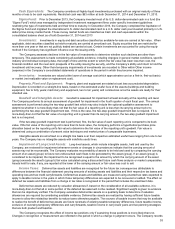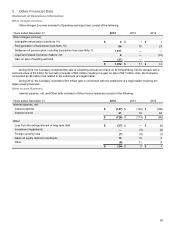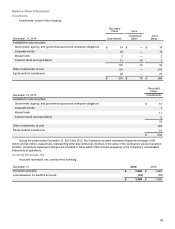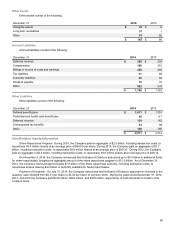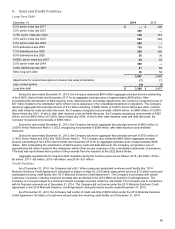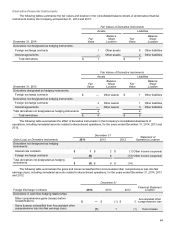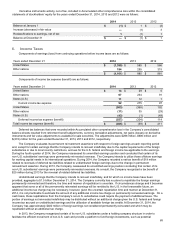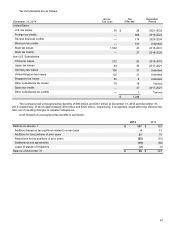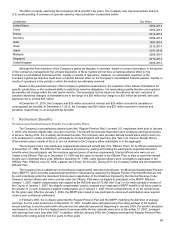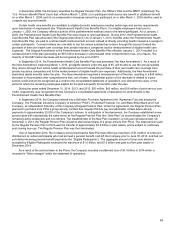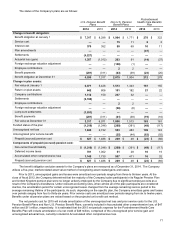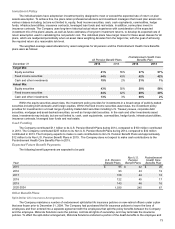Motorola 2014 Annual Report Download - page 65
Download and view the complete annual report
Please find page 65 of the 2014 Motorola annual report below. You can navigate through the pages in the report by either clicking on the pages listed below, or by using the keyword search tool below to find specific information within the annual report.
63
5. Risk Management
Foreign Currency Risk
The Company uses financial instruments to reduce its overall exposure to the effects of currency fluctuations on cash
flows. The Company’s policy prohibits speculation in financial instruments for profit on exchange rate price fluctuations, trading
in currencies for which there are no underlying exposures, or entering into transactions for any currency to intentionally increase
the underlying exposure. Instruments that are designated as part of a hedging relationship must be effective at reducing the risk
associated with the exposure being hedged and are designated as part of a hedging relationship at the inception of the contract.
Accordingly, changes in the market values of hedge instruments must be highly correlated with changes in market values of the
underlying hedged items both at the inception of the hedge and over the life of the hedge contract.
The Company’s strategy related to foreign exchange exposure management is to offset the gains or losses on the
financial instruments against gains or losses on the underlying operational cash flows or investments based on the Company's
assessment of risk. The Company enters into derivative contracts for some of its non-functional currency cash, receivables, and
payables, which are primarily denominated in major currencies that can be traded on open markets. The Company typically
uses forward contracts and options to hedge these currency exposures. In addition, the Company enters into derivative
contracts for some forecasted transactions, which are designated as part of a hedging relationship if it is determined that the
transaction qualifies for hedge accounting under the provisions of the authoritative accounting guidance for derivative
instruments and hedging activities. A portion of the Company’s exposure is from currencies that are not traded in liquid markets
and these are addressed, to the extent reasonably possible, by managing net asset positions, product pricing and component
sourcing.
At December 31, 2014, the Company had outstanding foreign exchange contracts totaling $628 million, compared to $837
million outstanding at December 31, 2013. Management believes that these financial instruments should not subject the
Company to undue risk due to foreign exchange movements because gains and losses on these contracts should generally
offset losses and gains on the underlying assets, liabilities and transactions, except for the ineffective portion of the instruments,
which is charged to Other within Other income (expense) in the Company’s consolidated statements of operations.
The following table shows the five largest net notional amounts of the positions to buy or sell foreign currency as of
December 31, 2014 and the corresponding positions as of December 31, 2013:
Notional Amount
Net Buy (Sell) by Currency 2014 2013
Euro $ 214 $ (132)
Chinese Renminbi (161) (181)
Norwegian Krone (90) (95)
Australian Dollar (42) (17)
British Pound 34 257
Interest Rate Risk
As part of its liability management program, one of the Company's European subsidiaries has outstanding interest rate
agreements (“Interest Agreements”) relating to Euro-denominated loans. The interest on the Euro-denominated loans is
variable. The Interest Agreements change the characteristics of interest rate payments from variable to maximum fixed-rate
payments. The Interest Agreements are not accounted for as a part of a hedging relationship and, accordingly, the changes in
the fair value of the Interest Agreements are included in Other income (expense) in the Company's consolidated statements of
operations. The weighted average fixed rate payment on the Interest Agreements for the year ended December 31, 2014 was
4.02%. The fair value of the Interest Agreements was a liability position of $2 million at December 31, 2014, compared to a
liability position of $3 million at December 31, 2013.
Counterparty Risk
The use of derivative financial instruments exposes the Company to counterparty credit risk in the event of
nonperformance by counterparties. However, the Company’s risk is limited to the fair value of the instruments when the
derivative is in an asset position. The Company actively monitors its exposure to credit risk. At present time, all of the
counterparties have investment grade credit ratings. The Company is not exposed to material credit risk with any single
counterparty. As of December 31, 2014, the Company was exposed to an aggregate credit risk of approximately $1 million with
all counterparties.


